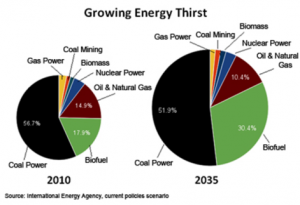If water scarcity is thought to be a problem now, just wait until 2035. The International Energy Agency (IEA) has reported that water consumption due to the production of energy sources such as coal-fired power plants, biofuels, and natural gas will rise from the 66 billion cubic meters (BCM) used back in 2010 to 135BCM in 2035. That’s equivalent to the water consumption of every resident in the United States for the next three years.
The IEA forecast shows that by 2035, coal-fired electricity and biofuels will represent roughly 80% of the 69BCM increase in energy’s water consumption, while fracking and natural gas will only account for 10% of future water consumption. With the United Nations predicting that 1.8 billion people will be living in water scarce areas by 2025, it is vitally important that action be taken now to curb energy production’s reliance on water worldwide.
Wind and solar energy could provide a low water alternative as they account for less than 1% of water consumption both now and by 2035, and – by nature – do not require water. Coal-fired plants, the largest consumer of water today and in the future, could switch to a dry cooling system as opposed to a wet cooling system. A dry cooling system uses air instead of water to cool down steam and could cut water consumption of coal-fired power plants by 90%. The downside of a dry cooling system is that these types of systems are not as efficient – and therefore are more expensive – compared to their wet cooling counterparts.
The amount of water consumed by biofuels can also be reduced switching from a surface spraying irrigation system to an irrigation pump. However, while an irrigation pump requires less water, it also requires more electricity.
The increasing amount of water that energy requires will have a greater impact on countries that are already struggling with their dwindling water supply. In the case of Abu Dhabi – a desert city- rising residential and commercial water demands have been doubling for the past ten years, and the country is struggling to keep up. The government says that their groundwater supply will only last for the next thirty years and their desalination system for the next fifty. Abu Dhabi is now attempting to use renewable energy like wind and solar due to the high cost of natural gas powered desalination.
Citizens of India and Pakistan who get their water supply from the Indus River are also in danger of losing their primary source of water. The glaciers that melt into the river are receding due to climate change and water levels could drop 40%. If this happens, those who rely on the Indus River for drinking water, irrigation, and livestock will find their major source of livelihood cut almost in half. 90% of Pakistan’s agriculture depends on the Indus River and if that water supply is no longer available, their economy will suffer.
As ASP has previously highlighted, developed countries such as China and India are also predicted to deplete their water supply within the next twenty years.
We should pay close attention to the IEA’s recommendations, not only to increase the efficacy of critically important emerging and traditional technologies but for humanitarian reasons as well.



